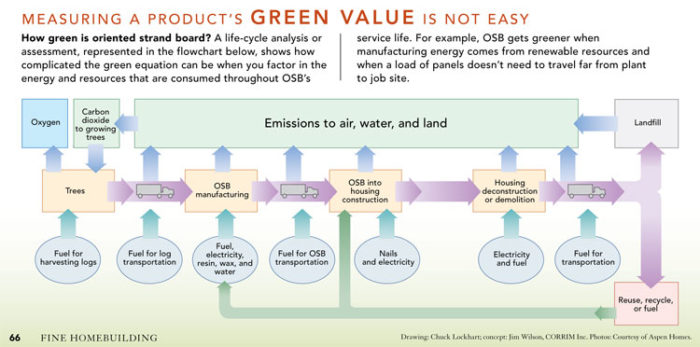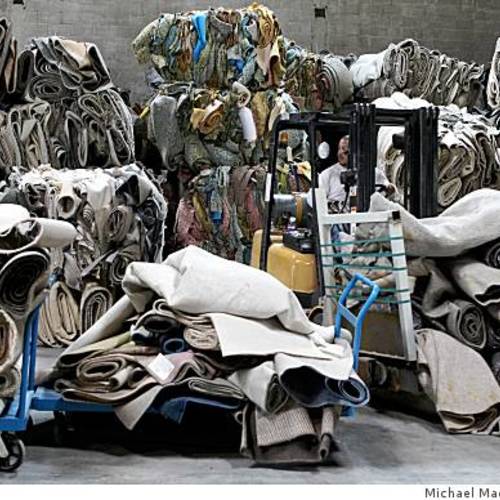
Image Credit: Fine Homebuilding
Are steel studs greener than wood? Is plastic pipe greener than copper? And is vinyl siding green? A product’s total environmental impact must be considered.
There are few green building topics that produce more frustration and uncertainty than claims about the environmental footprint of particular building materials. Life-cycle assessments seem like the perfect tool for summing it all up, but they fall short for many reasons.
Getting reliable data is difficult at best
A life-cycle assessment starts with a life-cycle inventory. That includes identifying and quantifying the inputs and outputs of a product from cradle to grave (mining, manufacturing, moving, installing, operating, and disposing of). This is no small task. And because much of the information comes from product manufacturers, the data can be incomplete. Manufacturers may not have all of the information, or they may be unwilling to share it. When all products in a life-cycle-assessment database are not scrutinized equally, conclusions drawn from the information may be misleading.
You can’t predict how many people will actually get cancer, only that a product could cause it
After the life-cycle inventory is put together, it must be translated into actual environmental impacts: global warming, human toxicity, ozone depletion, rainforest degradation, etc. This is called life-cycle impact assessment (LCIA), and it gets pretty hypothetical. Many of these environmental effects require assumptions, such as how many lives will be lost from a particular cancer-causing output. These assumptions are impossible for normal people to evaluate, so we have to rely on someone else’s professional judgment.
They make apples-to-oranges environmental comparisons
The environmental impacts associated with a product are wide ranging and measured in many different ways. For example, biodiversity may be gauged by the number of species going extinct and global warming by worldwide temperature rise. But how do we compare the two in relative importance? Again, it’s hard for normal people to evaluate the relative importance, so we must rely on trustworthy experts to weigh each impact category in essentially an apples-to-oranges process. Is ozone depletion twice as important as the acidification of lakes? Pick your poison.
Setting boundary conditions is subjective and fuzzy
In any analysis, deciding what is on the table and what is out of bounds or beyond the scope is an essential first step. What does this mean in environmental life-cycle assessment of building products? Three vexing examples provide valuable insight:
- Open-cell spray foam appears very green. It insulates and air seals, it has no VOC offgassing, uses water as the blowing agent, and it has proven quite durable. But when considered in the greater context of a building, its excellent adhesion makes recycling or reusing the wood to which it is stuck difficult or even impossible. Should the insulation/air sealing properties be evaluated alone or should their effect on other building materials be considered?
- Burning PVC is very bad. When burned in uncontrolled conditions, PVC creates a serious environmental hazard. But if PVC waste from construction is rarely involved in uncontrolled burning, should this issue be included in the environmental profile of PVC plumbing pipe? Should burning be a factor for other PVC products, but not those used in construction?
- Environmental regulations in other countries are often more lax that ours. A global manufacturer of paints has a good record of environmental compliance in the United States, but a lousy record in countries with lax environmental standards. Do we consider the environmental degradation in other countries if we know the paint we are using is produced in the United States?
Life-cycle assessment is not a waste of time
Does this mean that life-cycle assessments and comparing the environmental profiles of competing products are a complete waste of time? Does it really matter which products we use from an environmental standpoint? The answer is that the environmental footprint of a product matters, but it should be put in the proper context:
- Product selection should be among the last of the green building priorities. The energy efficiency, water efficiency, durability, and safety to human health of the building should be the top priorities.
- Use building products manufactured and/or assembled locally and optimize the use of all construction materials (use fewer studs, design in 2-ft. modules, etc.).
- For the more complex life-cycle assessment issues, go with product recommendations from a third-party, transparent, expert-based system such as GreenSpec.
Dive deeper: Life Cycle Assessment for Buildings: Seeking the Holy Grail
Environmental Building News, March 2002
Life Cycle 101
US EPA Life Cycle Assessment Research
Life-Cycle Assessment tools:
- A Sampling of LCA Tools (sidebar to the above EBN article)
- BEES—Building for Environmental and Economic Sustainability tool published by the National Institute of Standards and Technology
- The Athena Institute Environmental Impact Estimator
- Pharos Material Evaluation tool
–Peter Yost is Director-Residential Services at GreenBuildingAdvisor and Building Green.
Weekly Newsletter
Get building science and energy efficiency advice, plus special offers, in your inbox.















0 Comments
Log in or create an account to post a comment.
Sign up Log in